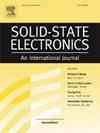Temperature influence on experimental analog behavior of MISHEMTs
IF 1.4
4区 物理与天体物理
Q3 ENGINEERING, ELECTRICAL & ELECTRONIC
引用次数: 0
Abstract
This work presents an analysis on experimental analog behavior of MISHEMTs operating in the temperature range from 450 K down to 200 K. The drain current (IDS) presented a slight anomaly, especially for temperatures lower than 400 K. In the transconductance it is possible to visualize a second peak, suggesting a second conduction. As shown, the transconductance presented a low dependence on gate length, and an anomaly was observed for the devices at 350 K. The output conductance and transistor efficiency behavior suggest a competition between the effects of the MOS and HEMT conductions, present in the device. A new kink was observed in the output characteristic (IDSxVDS) at room temperature, which is caused by the HEMT and MOS conductions interaction, and it is even more noticeable for higher overdrive voltages (VGT). This effect is called MISHEMT kink effect (MH-kink) in this work. The MH-kink shifts toward higher VDS for higher overdrive voltage, showing the stronger influence of the MOS conduction on the total drain current. The unity gain frequency (ft) increases from 800 MHz (450 K) to 1.8 GHz (200 K), while the AV goes in opposite direction from 43 dB (450 K) to 38 dB (200 K). Considering that the intrinsic voltage gain is good enough even at low temperatures, the MISHEMT can be identified as a good candidate for analog applications.
温度对 MISHEMT 模拟实验行为的影响
这项研究分析了在 450 K 至 200 K 温度范围内工作的 MISHEMT 的模拟实验行为。漏极电流(IDS)出现了轻微异常,尤其是在低于 400 K 的温度下。如图所示,跨导对栅极长度的依赖性较低,在 350 K 时器件出现异常。输出电导和晶体管效率行为表明,器件中存在 MOS 和 HEMT 传导效应之间的竞争。在室温下的输出特性(IDSxVDS)中观察到了一种新的扭结,这是 HEMT 和 MOS 导体相互作用造成的,在过驱动电压 (VGT) 较高时更为明显。这种效应在本文中称为 MISHEMT 扭结效应(MH-kink)。当过驱动电压升高时,MH-kink 会向更高的 VDS 方向移动,这表明 MOS 导通对漏极总电流的影响更大。统一增益频率 (ft) 从 800 MHz (450 K) 上升到 1.8 GHz (200 K),而 AV 则相反,从 43 dB (450 K) 下降到 38 dB (200 K)。考虑到即使在低温条件下,MISHEMT 的固有电压增益也足够好,因此可以确定它是模拟应用的理想候选器件。
本文章由计算机程序翻译,如有差异,请以英文原文为准。
求助全文
约1分钟内获得全文
求助全文
来源期刊

Solid-state Electronics
物理-工程:电子与电气
CiteScore
3.00
自引率
5.90%
发文量
212
审稿时长
3 months
期刊介绍:
It is the aim of this journal to bring together in one publication outstanding papers reporting new and original work in the following areas: (1) applications of solid-state physics and technology to electronics and optoelectronics, including theory and device design; (2) optical, electrical, morphological characterization techniques and parameter extraction of devices; (3) fabrication of semiconductor devices, and also device-related materials growth, measurement and evaluation; (4) the physics and modeling of submicron and nanoscale microelectronic and optoelectronic devices, including processing, measurement, and performance evaluation; (5) applications of numerical methods to the modeling and simulation of solid-state devices and processes; and (6) nanoscale electronic and optoelectronic devices, photovoltaics, sensors, and MEMS based on semiconductor and alternative electronic materials; (7) synthesis and electrooptical properties of materials for novel devices.
 求助内容:
求助内容: 应助结果提醒方式:
应助结果提醒方式:


